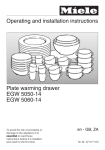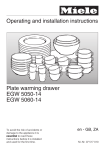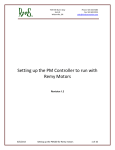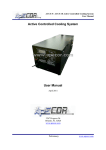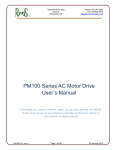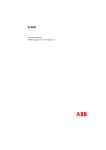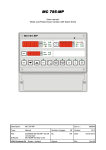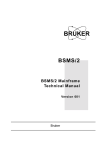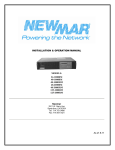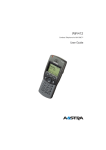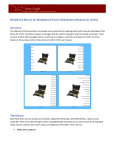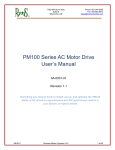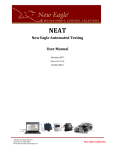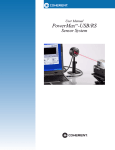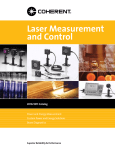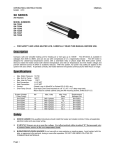Download PM Family Data Sheet
Transcript
PM FAMILY DATA SHEET RINEHART MOTION SYSTEMS LLC 7929 SW Burns Way, Suite B, Wilsonville, OR 97070 503.344.5085 AC Motor Controller for Electric and Hybrid Vehicles Product Summary The Rinehart Motion Systems LLC (RMS) PM Family of AC Motor Controllers are designed for on- and off-road Electric (EV) or Hybrid Electric (HEV) applications. The motor controller converts the DC power from the vehicle ESS (Energy Storage System / Battery) to the 3-phase AC required by the motor. These Traction drives are fabricated using a patented high heat flux thermal design approach that dramatically reduces the size and weight of the finished drive, and improves its life in the automotive environment. With extensive experience in automotive and military vehicle traction and power electronics applications, RMS has achieved a major breakthrough in integrating Motor Control into a vehicle. RMS offers several different models within the PM Family of motor controllers to suit the DC bus voltage and motor current requirements of your specific vehicle. The PM Family has been designed to operate with many types of motors, including Induction Motors (IM) and Permanent Magnet motors (PMSM or IPM). Contact RMS for the latest list of motors supported by our controllers. The Drive can also be tuned to your new motor - contact the factory for more information. The primary difference between models in the PM Family is the rated voltage and current (ultimate power output): Controller Model Maximum DC Voltage – PM100DX PM100DZ PM100DXR * PM150DX PM150DZ 360 V 720 V 400 V 360 V 720 V 500 V 900 V 500 V 500 V 900 V Motor Current Continuous 300 Arms 150 Arms 300 Arms 450 Arms 225 Arms Motor Current Peak ** 350 Arms 200 Arms 450 Arms 450 Arms 300 Arms 440 μF 280 μF 440 μF 880 μF 560 μF See drawing See drawing See drawing See drawing See drawing 7.5 kg 7.5 kg 7.5 kg 10.7 kg 10.7 kg operating Maximum DC Voltage – non-operating DC Bus Capacitance Size Weight Minimum Conductor Size 4 AWG 2 AWG 4 AWG*** Maximum Conductor Size 1 AWG 3/0 AWG 1 AWG Minimum Cable O.D. 9.0 mm 11.0 mm Maximum Cable O.D. 16.5 mm 21.0 mm * The PM100DXR is only available for special applications (i.e. racing), use must be approved by RMS. ** Peak current is defined as a maximum of 30 seconds. *** Depending on cable, it may be necessary to add additional sleeve to cable to meet the minimum Cable O.D. of the cable gland. Information subject to change without notice 1/5/2012 page 1 of 10 PM FAMILY DATA SHEET RINEHART MOTION SYSTEMS LLC 7929 SW Burns Way, Suite B, Wilsonville, OR 97070 503.344.5085 Power Production and Controller Ratings The mechanical power that can be generated by any motor controller is highly dependent on the motor characteristics. It is possible to estimate the actual motor output power you can achieve in any specific system if certain motor characteristics are known. A common misconception is that Motor Current times DC Bus Voltage will give the motor power. THIS IS INCORRECT. First, it is important to know the continuous and maximum (peak) motor current ratings. It is possible that the maximum motor current could be higher than the current rating of the motor controller. If so, then either a higher current controller can be considered or use the motor controller current limits in the below equations. The next important item to understand is the maximum motor voltage. In many circumstances the maximum motor voltage is limited by the available battery voltage. The available motor voltage from the Drive output terminals is a function of the DC bus voltage: For example, if the Battery pack voltage is 320V then the motor voltage the inverter can make can never exceed 226.27VRMSl-l. In practice the actual voltage is generally limited to ~95% of this value, so for design purposes the maximum motor voltage should be assumed to be 215.0 VRMSl-l(max). As the motor speed varies, the Drive will vary its output voltage to deliver the required power – until it reaches this hard limit due to the battery voltage. You can’t get any more. To go faster, the motor has to enter “field weakening”, where the Drive adds current to defeat some of the permanent magnet field, so the motor output voltage is reduced and stays below the hard limit – in this case 215VAC. If the maximum motor rated current is 300 Arms, you still can’t calculate how much mechanical power you can deliver without knowing the motor Power Factor and efficiency at that operating point. It’s not just how much current is flowing into the motor, but when it flows – its phase shift. Power Factor represents the 3-phase system phase shift that exists between the motor voltage and the motor current. The motor power factor varies from each different motor, motor type, and operating point. For this example assume a motor power factor of 0.768. Motor efficiency will also vary from motor to motor and over the speed/torque operating plane. Assume motor efficiency is 91.2%, typical of an SPM motor at peak load. We now have enough information to calculate the motor output power. For this example we get: Information subject to change without notice 1/5/2012 page 2 of 10 PM FAMILY DATA SHEET RINEHART MOTION SYSTEMS LLC 7929 SW Burns Way, Suite B, Wilsonville, OR 97070 503.344.5085 The DC Input Current to the motor controller is based on the motor input power and the efficiency of the motor controller. The motor controller efficiency will vary depending on the load conditions. However, for most high power conditions a typical efficiency of the PM Family of controllers is 97%. The total system efficiency can be found by multiplying the motor efficiency by the controller efficiency. For this example we would multiply 91.2% with 97% giving a system efficiency of 88.5%. The DC input power can now be calculated as: DC_Power = Pmech / .885 = Vbatt * Ibatt = 88.36kW To continue the example, the DC current would be 276 amps at 320V battery voltage (88.36kW/ Vbatt) General Specifications for the PM Family Description Value Short Circuit Protection Yes Hardware Over-current Protection Yes 9 .. 16VDC (12V Systems) Vehicle System Power -40 .. +80ºC Operating Temperature Range – coolant water – no derating Isolation – High-Voltage to Low-Voltage 1000Vrms Isolation – High-Voltage to Case 1000Vrms Isolation – Low-Voltage to Case 50V -40.. +105ºC Operating Temperature Range – coolant water – derated output power Non-Operating Temperature -40 .. +115ºC Storage Temperature -55 .. +105ºC Coolant Type 50/50 EGW Coolant Flow Rate 8 – 12 LPM 0.2 bar for PM100xx Coolant Pressure Drop 0.25 bar for PM150xx 1.4 bar Maximum Coolant Pressure (above ambient) Operating Shock (ISO 16750-3, Test 4.2.2.2) Operating Vibration (ISO 16750-3, 4.1.2.4 Test IV) 2 500 m/s (50g), pending testing 27.8 m/s2 (3grms), pending testing IP6K9K Environmental Protection Class (see ISO 20653) IEC, pending testing EMC compatibility Information subject to change without notice 1/5/2012 page 3 of 10 PM FAMILY DATA SHEET RINEHART MOTION SYSTEMS LLC 7929 SW Burns Way, Suite B, Wilsonville, OR 97070 503.344.5085 The PM Family of Motor Controllers comes with cable glands designed to accept shielded cable. Proper shielding and grounding of the motor controller cables is essential to control EMC that can effect motor operation and potentially other systems on the vehicle. The motor controller is designed with a wire clamping system that requires the use of a wire ferrule. Refer to the PM Family User’s Manual on making the High Voltage Connections to the PM100.RMS recommends Champlain Cable type EXRAD XLE 1000V shielded power cables for use with our products. The size of the wire used depends on the application – the motor peak and continuous current and how long those peaks are expected to last. For reference a size versus ampacity (continuous current handling capability) chart is copied here: Wire Size Ampacity 4 AWG 190 2 AWG 255 1 AWG 293 1/0 AWG 339 2/0 AWG 390 3/0 AWG 451 Each controller contains a significant amount of DC bus capacitance. It is necessary for the user to provide a pre-charge circuit for this capacitance. The PM motor controller does not present any practical limits on how small or large the pre-charge current is. However, the user should take care to design the circuit so that if the controller were to fail shorted the pre-charge circuit is not damaged and cannot start a fire. Pre-charge circuit operation may be controlled by the internal software - refer to the PM100 User’s Manual for more information. Control Software The PM Family of motor controllers comes with advanced motor control software developed by RMS. This software includes many features that are useful for control of an electric motor in an EV/Hybrid application. There is a rudimentary Vehicle Controller (simplistic VCU functionality) in the drive that may be enabled to operate the attached motor on the bench, or to drive a prototype vehicle around the parking lot in system integration. However, most safety sertified applications use the PM Drive as a CAN-based output node – a separate computer (the VCU) issues torque commands and reads feedback from the motor (and the battery management system, the driver inputs, etc) over the CAN serial port. For more information on the software refer to the PM100 User’s Manual. The PM Family of Drives can also be programmed with custom software, or with customer developed software. Contact RMS for more information. Information subject to change without notice 1/5/2012 page 4 of 10 PM FAMILY DATA SHEET RINEHART MOTION SYSTEMS LLC 7929 SW Burns Way, Suite B, Wilsonville, OR 97070 503.344.5085 Hardware Description The following section provides a brief description of the I/O hardware features of the PM family of motor controllers. To use these I/O features, please refer to the PM100 Users Manual. Feature Summary Generation 2* Feature Generation 3* Analog Inputs (0 – 5V) 4 6 RTD Inputs 2xPT100, 2xPT100/PT1000, 2xPT100 Selectable Digital Inputs 6 8 High Side Outputs 2 4 Low Side Outputs 2 2 Resolver Interface Yes Yes Quadrature Encoder Interface Yes Yes Hall Effect Sensor Interface No Yes CAN Interface Yes Yes RS-232 Interface Yes Yes * The PM150 family is implemented with Generation 3 Features. The PM100 family is currently implemented with Generation 2 Features, The PM100 family is expected to change to Generation 3 in Spring of 2012. Analog Inputs: Intended for general analog signal sensing (0 – 5V). RTD Inputs: Used to sense temperature. Digital Inputs: Intended for general interface to the vehicle and for feedback from external contactors and switchgear as required in the application. There are two types of inputs Switch To Ground and Switch To Battery. Refer to the user’s manual for more detail. High-Current Digital Outputs: High side outputs can be used for driving 12V loads. Low-side Outputs: Low side outputs can be used for driving 12V loads that switch the ground side of the load. Information subject to change without notice 1/5/2012 page 5 of 10 PM FAMILY DATA SHEET RINEHART MOTION SYSTEMS LLC 7929 SW Burns Way, Suite B, Wilsonville, OR 97070 503.344.5085 CAN Interface: There are two CAN2.0B compliant serial ports, capable of operation at 100k, 250k, 500k, and 1Mb/sec by software selection. The CAN terminator for each port can be applied or opened under software control during setup or at any time. EMI filtering for common-mode and differential-mode noise, and transient suppressors are used to improve the robustness of the serial I/O system. Refer to the PM100 CAN Manual for more information on the protocol implemented by RMS. RS-232 Serial Interface: There is one RS-232 serial interface with EMI filtering. This port can be used to set up and tune the controller, and to download controller software updates from a computer. RMS offers a simple serial user monitor that runs on the PC to allow changing parameters, changing the I/O functionality to suit the application needs, and other user-selectable optimizations. Encoder Interface: For applications that use an incremental optical or magnetic encoder, there is a 5V interface to power the external encoder and to receive, level translate, and filter the signals from A, B and INDEX channels. The sensor interface is designed to work with an open collector type sensor. The maximum frequency of the interface is 50 kHz. The DSP has specific hardware for wide dynamic range speed and angle calculation from the encoder data. Resolver Interface: A resolver can be used in place of the incremental encoder to determine machine rotor position and velocity. The resolver is excited by a precision sinusoid, and the sine and cosine winding outputs are filtered for noise and presented to the DSP to be digitized at 12b resolution. Due to the nature of the resolver interface the resolver excitation frequency is the same frequency as the PWM frequency. Hall Sensor Interface: A Hall Sensor Interface is provided for motors that use this type of position sensing. The interface includes A,B,C channel inputs as well as providing 5V power for the sensor. The sensor interface is designed to work with a open-collector type output. Low-Voltage Signal Connector Interface: The PM Family motor controllers use two connectors for the low-voltage signals (Tyco/AMP AMPSEAL family). The following connectors are used: Connector Connector Type Mating Connector Mating Contact Type Type J1 (35 pin) Tyco/AMP 776231-1 Tyco/AMP 776164-1 Tyco/AMP 770854-1 J2 (23 pin) Tyco/AMP 776228-1 Tyco/AMP 770680-1 Tyco/AMP 770854-1 Note: It is extremely important for proper operation of the connector to utilize the recommended crimp tool from Information subject to change without notice 1/5/2012 page 6 of 10 PM FAMILY DATA SHEET RINEHART MOTION SYSTEMS LLC 7929 SW Burns Way, Suite B, Wilsonville, OR 97070 503.344.5085 Tyco/AMP (Tyco/AMP part number 58529-1). A connector kit is available from RMS that includes the mating connectors and 60 contacts (RMS p/n G1-0001-01). The AMPSEAL contact is designed to work with 16-20 AWG wire with an insulation diameter between 1.70 – 2.70 mm. Make sure that the wire used conforms to these requirements. Information subject to change without notice 1/5/2012 page 7 of 10 PM FAMILY DATA SHEET RINEHART MOTION SYSTEMS LLC 7929 SW Burns Way, Suite B, Wilsonville, OR 97070 503.344.5085 Outline Drawings: PM100 Package Outline: Information subject to change without notice 1/5/2012 page 8 of 10 PM FAMILY DATA SHEET RINEHART MOTION SYSTEMS LLC 7929 SW Burns Way, Suite B, Wilsonville, OR 97070 503.344.5085 PM150 Package Outline Information subject to change without notice 1/5/2012 page 9 of 10 PM FAMILY DATA SHEET RINEHART MOTION SYSTEMS LLC 7929 SW Burns Way, Suite B, Wilsonville, OR 97070 503.344.5085 Contacts: SALES USA SALES ASIA Contact: Rich Swortzel Contact: Dr. Steve Shi New Eagle Business Development Eontronix Co. Ltd. [email protected] [email protected] 734-649-8156 Voice 734-330-3800 Voice 928-395-2114 Fax 734-468-4085 Fax www.neweagle.net www.eontronix.com FACTORY Rinehart Motion Systems [email protected] 503-344-5085 Voice 503-682-9014 Fax www.rinehartmotion.com Information subject to change without notice 1/5/2012 page 10 of 10










